I had to take a medical leave from University College Cork for the fall semester, and so by the time I returned to Ireland in January, I was anxious to make up for lost time. One of my top priorities was to visit the quaint villages and historic sites scattered around the Emerald Isle. When I found that I shared a day off from classes with Maggie, I jumped on the opportunity to plan an outing. The trip we took — a day-trip to the small town of Kilkenny – turned out to be one of most memorable experiences I’ve had in Ireland so far.
Kilkenny is an old Anglo-friendly stronghold in the middle of the Republic, punctuated with several historic churches and cathedrals and the famously opulent Kilkenny Castle. We spent the day listening to tour guides, snapping pictures, enjoying the cuisine, and shopping for matching mementos (we were unsuccessful). Two parts of the trip were particularly memorable:
On our tour of Kilkenny Castle, we were both impressed by the staid portraits of aristocrats. Maggie found one of the subjects particularly compelling, and asked a nearby docent about the subject’s story. After providing a thorough history of the subject’s role in the aristocracy, the docent made a poignant analysis of our current place in history: while the subject was gorgeous in the portrait, she was almost definitely not as beautiful in real life. He explained artists would often embellish their subjects’ appearance. I study public health at UCC, and within the field of public health, several have hypothesized that social media gives people a glamorized sense of other people’s realities, causing stress. While social media widens this phenomenon, these portraits demonstrated that it wasn’t entirely absent hundreds of years ago. I pondered that point throughout the rest of the day, even as we scrutinized our selfies.
In the afternoon, we visited St. Canice’s Cathedral, which dates back to the 13th century. As we walked in, I saw someone walk into a small cutout of a cylindrical tower. I excitedly turned to Maggie, hoping that we could climb the tower as part of the tour. When we discovered climbing the tower cost just two extra Euro, Maggie, indifferent to medieval tower climbing, obliged. I began climbing the stairs only to discover that, once inside the 1100-year-old tower, stairs gave way to a series of steeply inclined ladders. After just a few flights, I developed a sudden onset fear of heights. Maggie had to coax me up the remaining steps. The view from the top was magnificent — but then I had to figure out how I’d get down. After assuring me that a helicopter rescue was unlikely, Maggie coaxed me back down the stairs – walking backwards the entire way. Each step was a trust exercise.
On the bus back to Cork, it dawned on me that, without the Mitchell Scholarship, I’d likely never meet someone like Maggie. We have vastly different interests – she studies national defense and diplomacy, while I work in health and economics. She lived an international childhood, inhabiting several countries I’d have to look up on a map. Until this year, I’d spent my entire life in the contiguous 48. We have different political views, different career aspirations, and were involved in different activities in college. Despite (or because of) our differences, however, we now share unforgettable memories of Kilkenny. Though I’ve only been in Ireland three months, I know I am part of the Mitchell family, and I’ve enjoyed every minute I’ve gotten to spend with the other Mitchells. I look forward to the adventures I’ll share with my Mitchell family this year and beyond — in fact, I’m writing this post from Tyler’s room in Dublin!

